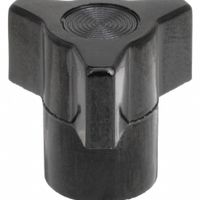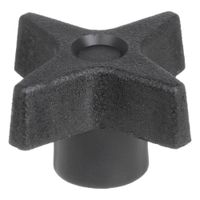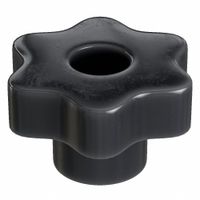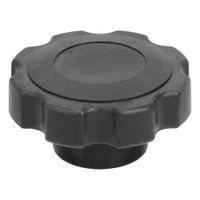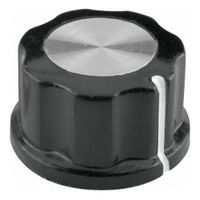Call +(254) 703 030 000 / 751 483 999 / 721 704 777
- Home
- Hardware
- Handles Pulls Knobs
- Hand Knobs
.....Read More
Frequently Asked Questions
What are hand knobs used for?
Hand knobs are versatile components used in various applications to provide a secure grip for manual adjustments, tightening, or loosening of equipment and machinery. They are commonly found in industrial, commercial, and consumer products, serving as user-friendly interfaces for controlling or securing parts without the need for additional tools.
In industrial settings, hand knobs are often used on machinery and equipment to allow operators to make quick adjustments or secure components in place. This can include adjusting the height of a machine part, securing a cover or panel, or locking a component in a specific position. The ergonomic design of hand knobs ensures that users can apply the necessary force comfortably and efficiently.
In the commercial sector, hand knobs are frequently used in furniture, fixtures, and displays. For example, they can be found on adjustable chairs, tables, and shelving units, allowing users to customize the height or angle to their preference. In retail displays, hand knobs enable quick reconfiguration of shelving or signage to accommodate different products or promotional layouts.
In consumer products, hand knobs are used in a variety of applications, such as on musical instruments, sports equipment, and household appliances. They provide a convenient way for users to make adjustments, such as tuning a guitar, adjusting the tension on exercise equipment, or setting the temperature on a kitchen appliance.
Hand knobs come in various shapes, sizes, and materials, including plastic, metal, and rubber, to suit different applications and environments. They may feature different grip styles, such as star, wing, or T-handle designs, to provide optimal control and comfort for the user. Overall, hand knobs are essential components that enhance the functionality and usability of a wide range of products and equipment.
How do you choose the right hand knob for a specific application?
To choose the right hand knob for a specific application, consider the following factors:
1. **Functionality**: Determine the primary function of the knob. Is it for gripping, turning, pulling, or pushing? The function will dictate the design and material.
2. **Material**: Choose a material that suits the environment and usage. Common materials include plastic, metal, wood, and rubber. For high-temperature or corrosive environments, metal or heat-resistant plastics are preferable.
3. **Size and Ergonomics**: Ensure the knob is the right size for the user's hand and the application. Ergonomically designed knobs reduce strain and improve comfort, especially for frequent use.
4. **Design and Aesthetics**: Consider the visual appeal and how the knob complements the overall design of the equipment or furniture. This is particularly important in consumer products.
5. **Durability and Strength**: Assess the knob's durability based on the expected wear and tear. For heavy-duty applications, choose robust materials like metal or reinforced plastic.
6. **Installation and Compatibility**: Ensure the knob is compatible with the existing hardware. Check the mounting type (threaded, push-on, etc.) and size specifications.
7. **Safety**: For applications involving machinery or equipment, safety is paramount. Choose knobs with non-slip surfaces or safety features to prevent accidents.
8. **Cost**: Balance quality with budget constraints. While cheaper options may be tempting, investing in a durable, high-quality knob can save costs in the long run.
9. **Regulatory Compliance**: Ensure the knob meets any industry-specific standards or regulations, especially in sectors like healthcare or food service.
10. **Feedback and Reviews**: Consider user reviews and feedback for insights into performance and reliability.
By evaluating these factors, you can select a hand knob that meets the specific needs of your application effectively.
What materials are hand knobs typically made from?
Hand knobs are typically made from a variety of materials, each chosen for specific properties that suit different applications. Common materials include:
1. **Plastic**: Often used for its lightweight, cost-effectiveness, and resistance to corrosion. Types of plastic used include thermoplastics like polypropylene, nylon, and ABS, which offer good durability and a comfortable grip.
2. **Metal**: Metals such as aluminum, stainless steel, and brass are used for their strength, durability, and aesthetic appeal. Stainless steel is particularly favored for its corrosion resistance, making it suitable for harsh environments.
3. **Bakelite**: A type of thermosetting plastic, Bakelite is known for its heat resistance and electrical insulating properties. It is often used in applications where these characteristics are important.
4. **Rubber**: Used for its non-slip properties and comfort, rubber is often employed in environments where grip is crucial, such as in wet or oily conditions.
5. **Wood**: Although less common in industrial settings, wood is used for its aesthetic appeal and natural feel. It is often found in furniture or decorative applications.
6. **Composite Materials**: These are used to combine the benefits of different materials, such as strength and lightweight properties, to meet specific application needs.
The choice of material depends on factors such as the environment in which the knob will be used, the required durability, aesthetic considerations, and cost constraints.
How do you install a hand knob?
To install a hand knob, follow these steps:
1. **Select the Knob**: Choose a knob that fits the style and size requirements of your door or drawer.
2. **Gather Tools**: You will need a screwdriver, a drill with a drill bit (if necessary), a measuring tape, and a pencil.
3. **Mark the Position**: Use the measuring tape to find the center of the door or drawer where the knob will be installed. Mark this spot with a pencil.
4. **Drill a Hole**: If there isn’t a pre-existing hole, use a drill with an appropriate-sized drill bit to create a hole at the marked spot. Ensure the hole is straight and clean.
5. **Align the Knob**: Insert the screw through the back of the door or drawer, aligning it with the hole in the knob.
6. **Attach the Knob**: Place the knob over the protruding screw. Hold the knob in place with one hand.
7. **Tighten the Screw**: Use a screwdriver to tighten the screw from the back, securing the knob in place. Ensure it is snug but not overly tight to avoid damaging the knob or the surface.
8. **Check Alignment**: Ensure the knob is straight and aligned properly. Adjust if necessary.
9. **Test the Knob**: Open and close the door or drawer to ensure the knob is securely attached and functions smoothly.
10. **Final Adjustments**: Make any final adjustments to ensure the knob is tight and aligned correctly.
By following these steps, you can successfully install a hand knob on a door or drawer.
What are the different types of hand knobs available?
Hand knobs come in various types, each designed for specific applications and user preferences. Here are some common types:
1. **Star Knobs**: Featuring a star-like shape, these knobs provide a firm grip and are ideal for applications requiring frequent adjustments.
2. **Wing Knobs**: Shaped like wings, these knobs allow for easy turning and are often used in applications where quick adjustments are necessary.
3. **Ball Knobs**: These spherical knobs offer a comfortable grip and are typically used in applications where aesthetics and ergonomics are important.
4. **T-Knobs**: Shaped like the letter "T", these knobs provide leverage for tightening and loosening, making them suitable for applications requiring more torque.
5. **Fluted Knobs**: With a fluted design, these knobs offer enhanced grip and are often used in machinery and equipment.
6. **Knurled Knobs**: Featuring a textured surface, knurled knobs provide a non-slip grip, ideal for precision adjustments.
7. **Push-Pull Knobs**: Designed for applications where knobs need to be pulled or pushed, these are often used in control panels.
8. **Thumb Screw Knobs**: These knobs are integrated with a screw, allowing for easy hand tightening without tools.
9. **Clamping Knobs**: Used to secure components in place, these knobs are common in woodworking and metalworking.
10. **Lobe Knobs**: With multiple lobes, these knobs offer a comfortable grip and are used in various industrial applications.
11. **Lever Knobs**: Featuring a lever for easy operation, these knobs are used in applications requiring quick adjustments.
12. **Round Knobs**: Simple and versatile, round knobs are used in a wide range of applications for basic turning functions.
Each type of hand knob is designed to meet specific functional and ergonomic needs, making them suitable for diverse industrial, commercial, and consumer applications.
How do you maintain and care for hand knobs?
To maintain and care for hand knobs, follow these steps:
1. **Regular Cleaning**: Use a soft cloth dampened with mild soapy water to wipe the knobs. Avoid abrasive cleaners that can damage the finish. For metal knobs, a mixture of vinegar and water can help remove grime.
2. **Polishing**: For metal knobs, apply a metal polish to restore shine. For wooden knobs, use a wood polish or wax to maintain their luster and protect the surface.
3. **Lubrication**: If the knobs are part of a mechanism, apply a small amount of lubricant like WD-40 to ensure smooth operation. Avoid over-lubricating, which can attract dust and dirt.
4. **Tightening**: Regularly check the knobs for looseness. Use a screwdriver to tighten any screws or bolts to ensure they remain securely attached.
5. **Inspect for Damage**: Periodically inspect the knobs for signs of wear or damage. Replace any knobs that are cracked or broken to maintain functionality and aesthetics.
6. **Avoid Excessive Force**: Use knobs gently to prevent unnecessary stress and potential damage. Teach children to handle them with care.
7. **Environmental Considerations**: Keep knobs away from extreme temperatures and humidity, which can cause warping or corrosion, especially for wooden and metal knobs.
8. **Protective Coating**: Apply a protective coating or sealant to metal knobs to prevent rust and corrosion. For wooden knobs, a clear varnish can protect against moisture.
9. **Storage**: If knobs are not in use, store them in a dry, cool place to prevent damage from environmental factors.
By following these steps, you can ensure that your hand knobs remain functional and aesthetically pleasing for a long time.
Where can I buy hand knobs?
You can buy hand knobs from a variety of sources, both online and in physical stores. Here are some options:
1. **Online Retailers**: Websites like Amazon, eBay, and Walmart offer a wide range of hand knobs in different sizes, materials, and designs. These platforms often provide customer reviews and ratings, which can help you make an informed decision.
2. **Specialty Hardware Stores**: Websites such as McMaster-Carr, Grainger, and Rockler specialize in hardware and industrial supplies, including hand knobs. They offer detailed product specifications and are ideal for finding specific or high-quality items.
3. **Home Improvement Stores**: Chains like Home Depot and Lowe’s have both online and physical stores where you can find hand knobs. They offer a variety of options suitable for home projects and provide the convenience of in-store pickup.
4. **Industrial Suppliers**: Companies like MSC Industrial Supply and Fastenal cater to industrial and commercial needs, offering a wide selection of hand knobs for machinery and equipment.
5. **Local Hardware Stores**: Smaller, independent hardware stores often carry hand knobs and can provide personalized service and advice. They may also be able to order specific items for you if they are not in stock.
6. **Manufacturer Websites**: Some manufacturers sell directly to consumers through their websites. This can be a good option if you are looking for a specific brand or type of hand knob.
7. **Online Marketplaces for Crafts and DIY**: Platforms like Etsy may have unique or custom-made hand knobs, often crafted by artisans.
8. **Auction Sites**: Websites like GovDeals or Liquidation.com sometimes have bulk lots of hardware, including hand knobs, available for auction.
Consider factors such as price, shipping options, return policies, and customer service when choosing where to buy.
